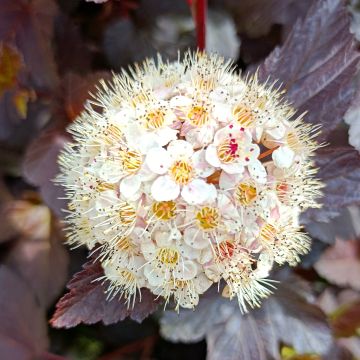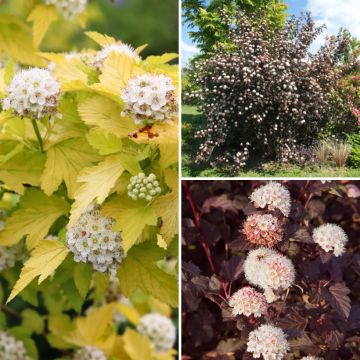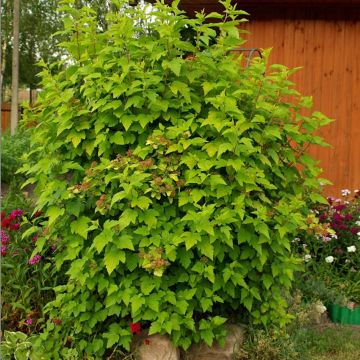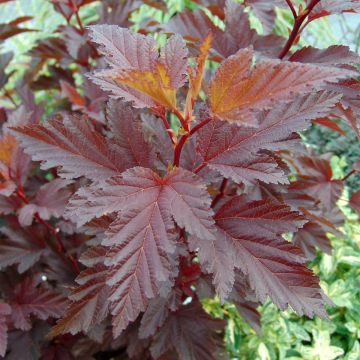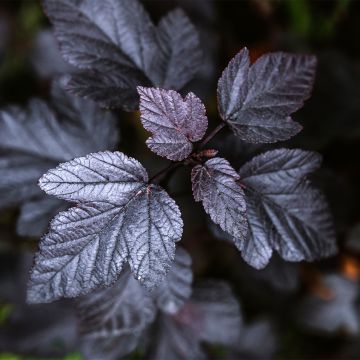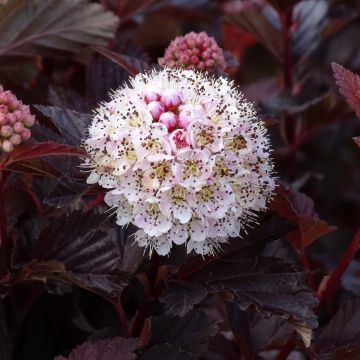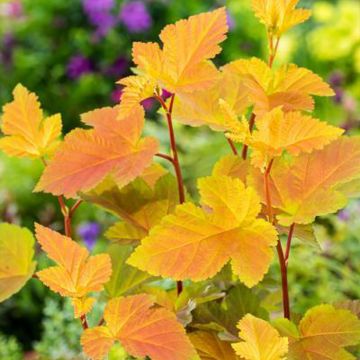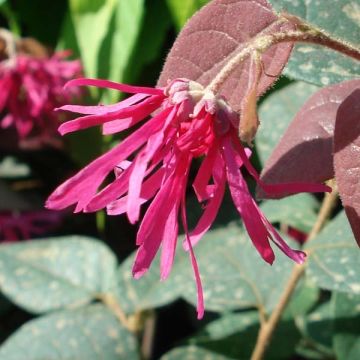

Physocarpus opulifolius - Ninebark


Physocarpus opulifolius - Ninebark


Physocarpus opulifolius - Ninebark
Physocarpus opulifolius - Ninebark
Physocarpus opulifolius
Ninebark
Why not try an alternative variety in stock?
View all →This plant carries a 24 months recovery warranty
More information
We guarantee the quality of our plants for a full growing cycle, and will replace at our expense any plant that fails to recover under normal climatic and planting conditions.
From €5.90 for pickup delivery and €6.90 for home delivery
Express home delivery from €8.90.
Does this plant fit my garden?
Set up your Plantfit profile →
Description
Physocarpus opulifolius or Ninebark is a deciduous bush with a naturally graceful trailing habit and foliage that changes colour throughout the seasons. It dazzles the garden in the spring with beautiful shades of purple-red or golden yellow, and again in the autumn with a foliage that ranges from yellow to orange, red, and purple before falling. The vibrant foliage is accompanied by reddish fruits. In early summer, it produces purple buds that open into white-pink umbels of flowers. Easy to grow as a free hedge or on the edge of a garden in moist soil.
Physocarpus opulifolius belongs to the Rosaceae family and is native to the eastern United States, Quebec, and Manitoba. This bush has a medium to fast growth rate and can reach a mature size of 1.50 to 3 metres (5 to 10 feet) in all directions in its natural habitat, with a dense and bushy habit that tends to sucker. The initially upright branches arch with age, giving the bush a graceful and natural appearance. Noteworthy for its young leaves that emerge in a reddish hue, it becomes even more astonishing when they blaze in autumn. The trilobed leaves, deeply cut and serrated, measuring 5 to 8cm (2 to 3in), resemble the leaves of Viburnum opulus, hence its species name "opulifolius". After the spring reddening, they adopt a bright yellowish-green colour. They are deciduous, alternate, with well-defined veins. The spectacle of the foliage continues when the flowering occurs, from May to July. It takes the form of flat corymbs adorned with purple buds that open into small white to pink flowers, nectar-rich and highly visited by pollinating insects. They are followed by red fruits in the shape of small bladders, appreciated by birds in autumn. The bush, bare of leaves in winter, remains decorative with its exfoliating bark, ranging from beige to reddish-brown.
The visually striking Ninebark will find its place in a flower bed, creating contrasts with light or golden foliage shrubs. It will be charming as an informal hedge, alongside spireas (Spirea arguta, Spirea x billardii), viburnums, winged Euonymus (Euonymus alatus), or a Neillia affinis that it will illuminate. To accompany its changing colours, Heucherellas, for example, can be planted at its base.
The name of Physocarpus opulifolius comes from the Greek 'phusa' which means air bubble or bladder, and 'karpos' which refers to the fruit, in reference to the fruit's shape. The resemblance of its foliage to that of Viburnum opulus earned it the specific name "opulifolius". Introduced to Europe around 1687, the numerous vibrant cultivars created in recent years have led to its strong resurgence in gardens.
Report an error about the product description
Physocarpus opulifolius - Ninebark in pictures




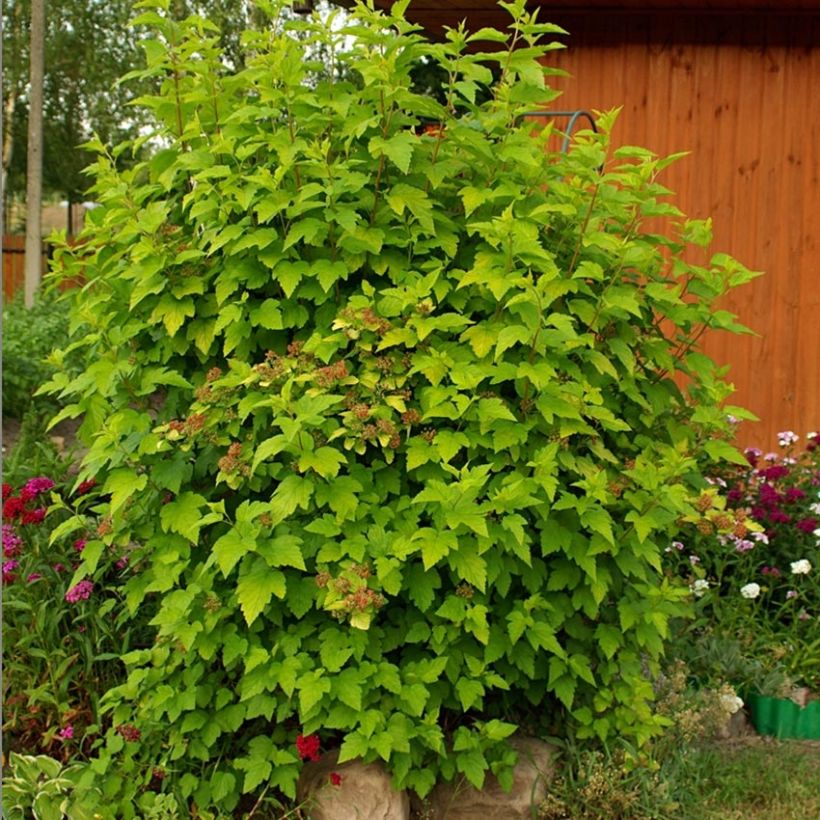

Plant habit
Flowering
Foliage
Botanical data
Physocarpus
opulifolius
Rosaceae
Ninebark
North America
Other Physocarpus
Planting and care
Plant Physocarpus opulifolius in deep, humus-rich, fertile and moist soil, preferably neutral to acidic. It only fears an excess of limestone and thrives in poor soils. Avoid letting the soil dry out in summer and shower the foliage during heatwaves. This bush will thrive in partial shade or full sun, but the foliage colours will be more pronounced if planted in a sunny location. Thin out dense plants by pruning severely some of the arching stems after flowering. This may encourage the emergence of new flower buds in late summer. Physocarpus tends to produce numerous shoots at the expense of the main stem; it can be useful to prune it very short, close to the stump, to give it a denser appearance.
Planting period
Intended location
Care
This item has not been reviewed yet - be the first to leave a review about it.
Hedge shrubs
Haven't found what you were looking for?
Hardiness is the lowest winter temperature a plant can endure without suffering serious damage or even dying. However, hardiness is affected by location (a sheltered area, such as a patio), protection (winter cover) and soil type (hardiness is improved by well-drained soil).

Photo Sharing Terms & Conditions
In order to encourage gardeners to interact and share their experiences, Promesse de fleurs offers various media enabling content to be uploaded onto its Site - in particular via the ‘Photo sharing’ module.
The User agrees to refrain from:
- Posting any content that is illegal, prejudicial, insulting, racist, inciteful to hatred, revisionist, contrary to public decency, that infringes on privacy or on the privacy rights of third parties, in particular the publicity rights of persons and goods, intellectual property rights, or the right to privacy.
- Submitting content on behalf of a third party;
- Impersonate the identity of a third party and/or publish any personal information about a third party;
In general, the User undertakes to refrain from any unethical behaviour.
All Content (in particular text, comments, files, images, photos, videos, creative works, etc.), which may be subject to property or intellectual property rights, image or other private rights, shall remain the property of the User, subject to the limited rights granted by the terms of the licence granted by Promesse de fleurs as stated below. Users are at liberty to publish or not to publish such Content on the Site, notably via the ‘Photo Sharing’ facility, and accept that this Content shall be made public and freely accessible, notably on the Internet.
Users further acknowledge, undertake to have ,and guarantee that they hold all necessary rights and permissions to publish such material on the Site, in particular with regard to the legislation in force pertaining to any privacy, property, intellectual property, image, or contractual rights, or rights of any other nature. By publishing such Content on the Site, Users acknowledge accepting full liability as publishers of the Content within the meaning of the law, and grant Promesse de fleurs, free of charge, an inclusive, worldwide licence for the said Content for the entire duration of its publication, including all reproduction, representation, up/downloading, displaying, performing, transmission, and storage rights.
Users also grant permission for their name to be linked to the Content and accept that this link may not always be made available.
By engaging in posting material, Users consent to their Content becoming automatically accessible on the Internet, in particular on other sites and/or blogs and/or web pages of the Promesse de fleurs site, including in particular social pages and the Promesse de fleurs catalogue.
Users may secure the removal of entrusted content free of charge by issuing a simple request via our contact form.
The flowering period indicated on our website applies to countries and regions located in USDA zone 8 (France, the United Kingdom, Ireland, the Netherlands, etc.)
It will vary according to where you live:
- In zones 9 to 10 (Italy, Spain, Greece, etc.), flowering will occur about 2 to 4 weeks earlier.
- In zones 6 to 7 (Germany, Poland, Slovenia, and lower mountainous regions), flowering will be delayed by 2 to 3 weeks.
- In zone 5 (Central Europe, Scandinavia), blooming will be delayed by 3 to 5 weeks.
In temperate climates, pruning of spring-flowering shrubs (forsythia, spireas, etc.) should be done just after flowering.
Pruning of summer-flowering shrubs (Indian Lilac, Perovskia, etc.) can be done in winter or spring.
In cold regions as well as with frost-sensitive plants, avoid pruning too early when severe frosts may still occur.
The planting period indicated on our website applies to countries and regions located in USDA zone 8 (France, United Kingdom, Ireland, Netherlands).
It will vary according to where you live:
- In Mediterranean zones (Marseille, Madrid, Milan, etc.), autumn and winter are the best planting periods.
- In continental zones (Strasbourg, Munich, Vienna, etc.), delay planting by 2 to 3 weeks in spring and bring it forward by 2 to 4 weeks in autumn.
- In mountainous regions (the Alps, Pyrenees, Carpathians, etc.), it is best to plant in late spring (May-June) or late summer (August-September).
The harvesting period indicated on our website applies to countries and regions in USDA zone 8 (France, England, Ireland, the Netherlands).
In colder areas (Scandinavia, Poland, Austria...) fruit and vegetable harvests are likely to be delayed by 3-4 weeks.
In warmer areas (Italy, Spain, Greece, etc.), harvesting will probably take place earlier, depending on weather conditions.
The sowing periods indicated on our website apply to countries and regions within USDA Zone 8 (France, UK, Ireland, Netherlands).
In colder areas (Scandinavia, Poland, Austria...), delay any outdoor sowing by 3-4 weeks, or sow under glass.
In warmer climes (Italy, Spain, Greece, etc.), bring outdoor sowing forward by a few weeks.

































